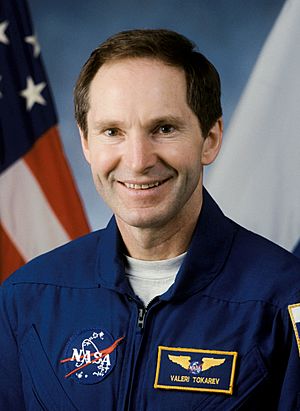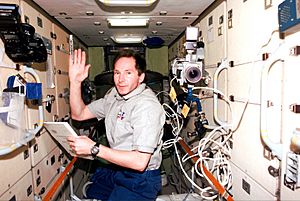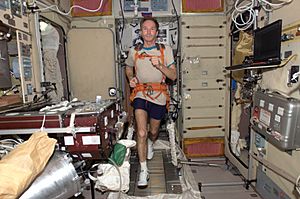Valeri Tokarev facts for kids
Quick facts for kids
Valeri Ivanovich Tokarev
|
|
|---|---|

Tokarev in a NASA uniform
|
|
| Born | 29 October 1952 Kapustin Yar, Astrakhan Oblast, Soviet Union
|
| Status | Retired |
| Nationality | Russian |
| Occupation | Pilot |
| Awards | Hero of the Russian Federation |
| Space career | |
| Roscosmos cosmonaut | |
| Rank | Air force colonel |
|
Time in space
|
199d 15h 06m |
| Selection | 1989 Cosmonaut Group |
| Missions | STS-96, Soyuz TMA-7 (Expedition 12) |
|
Mission insignia
|
 |
Valeri Ivanovich Tokarev (Russian: Валерий Иванович Токарев; born 29 October 1952) is a retired Russian Air Force colonel and test cosmonaut. He worked at the Yuri A. Gagarin Cosmonaut Training Center. Tokarev flew to space two times and completed two spacewalks. He retired in June 2008.
In March 2009, Tokarev joined the United Russia political party. In September 2013, he was chosen to lead Zvyozdny Gorodok. This is a special town where cosmonauts live and train. He served as its head for five years.
Contents
About Valeri Tokarev
Tokarev was born on October 29, 1952, in Kapustin Yar, which was part of the Soviet Union. He is married to Irina Tokareva. They have two children, a daughter named Olya and a son named Ivan. The family lives in Star City, near Moscow.
Valeri's mother, Lidiya, lives in the city of Rostov. His father, Ivan Pavlovich, passed away in 1972. Tokarev enjoys nature, automobiles, airplanes, and sports.
Tokarev's Training and Skills
In 1973, Tokarev finished his studies at the Stavropol Higher Military Aviation School. He became a pilot and navigator. Later, in 1982, he graduated with honors from the Test Pilot Training Center.
From 1989 to 1993, he continued his education at the Yu. A. Gagarin Military Air Academy. He also earned a master's degree in state administration in 1997.
Pilot Experience
Tokarev is a top-level Air Force Pilot and Test Pilot. He has flown 44 different types of airplanes and helicopters. He has spent more than 3,000 hours flying.
He helped test many advanced aircraft. These included jets that could take off and land vertically or in short distances. He also tested bomber and missile jets for the navy.
Cosmonaut Career
In 1987, Valeri Tokarev was chosen to become a cosmonaut. He was part of the team that would test and fly the Buran spacecraft. From 1994, he led a group of cosmonauts for aerospace systems.
The Buran program ended in 1997. After that, Tokarev became a test cosmonaut at the Yuri A. Gagarin Cosmonaut Training Center.
STS-96 Mission
Tokarev's first space mission was STS-96. It launched on May 27, 1999. This mission was flown by the Space Shuttle Discovery to the International Space Station (ISS). It was the first time a space shuttle docked with the ISS.
Tokarev worked as a mission specialist on this flight. During the 10-day mission, the crew delivered four tons of supplies to the ISS. This prepared the station for its first long-term crew. Tokarev helped move items and check equipment. He also worked with other astronauts to replace battery parts in the Zarya module. He even added sound insulation to make the module quieter.
On June 1, Tokarev answered questions from Russian reporters about the mission. The Discovery landed safely on June 6, 1999. The mission lasted 235 hours and 13 minutes.
Expedition 12 to the ISS
Tokarev was a flight engineer for the Expedition 12 crew on the ISS. He arrived at the station aboard the Soyuz TMA-7 spacecraft on October 3, 2005. The Soyuz TMA-7 launched on October 1, 2005. It carried Tokarev, NASA astronaut William McArthur, and U.S. space tourist Gregory Olsen.
After two days, the Soyuz TMA-7 docked with the Pirs module on the ISS. Tokarev performed many Russian science experiments. These included studies in biology, microbiology, genetics, and physics. One experiment, called Plants, allowed them to grow peas and greens in space.
He also did medical experiments to see how space affects humans and blood cells. His physics research looked at the upper layers of Earth's atmosphere. This helped scientists understand how spacecraft affect the atmosphere. During Expedition 12, a cargo ship called Progress M-55 brought more supplies to the station.
Tokarev left the ISS on April 6, 2006. He, McArthur, and Brazilian space traveler Marcos Pontes returned to Earth on April 8, 2006. Their Soyuz TMA-7 capsule landed in Kazakhstan. Tokarev spent 189 days, 19 hours, and 53 minutes in space on this mission.
Spacewalks
Tokarev has completed two spacewalks during his career. He spent a total of 11 hours and 5 minutes outside the ISS.
First Spacewalk
On November 7, 2005, Tokarev performed his first spacewalk. It lasted 5 hours and 22 minutes. He worked with NASA astronaut William McArthur. They installed a new camera and threw away a broken sensor called the Floating Potential Probe. They also completed other tasks.
Tokarev wore an all-white suit for this spacewalk. They spent over two hours installing the camera on the Port 1 Truss. Then, they moved to the Floating Potential Probe. This sensor was designed to measure the station's electrical charge. Tokarev and McArthur carefully released it and sent it floating away from the station. They also replaced a power control module.
Second Spacewalk
Tokarev's second spacewalk was on February 3, 2006. He and McArthur wore red-striped Orlan suits. They left the ISS from the Pirs docking compartment. This spacewalk lasted 5 hours and 43 minutes.
During this spacewalk, they moved a boom adapter for a Russian crane called Strela. They also collected experiments from outside the station. They inspected and took pictures of parts of the station's exterior.
A very interesting part of this spacewalk was when they threw away an old Russian Orlan spacesuit. This suit, named SuitSat-1, had a radio inside. It broadcasted greetings in six languages to ham radio operators around the world. The suit stopped transmitting after about two orbits. It was expected to burn up in Earth's atmosphere a few weeks later.
Awards and Honors
Valeri Tokarev has received many awards for his service.
- He was given the "Hero of the Russian Federation" medal in 2000.
- He earned the title of Pilot Cosmonaut of the Russian Federation in 1999.
- He received the Gold Star Medal of the Hero of the Russian Federation.
- He was awarded the Order for Service to Motherland in the USSR Air Forces Third Class in 1978.
- He also received Russian Federation Medals and the NASA Space Flight Medal in 1999.
- He is an Honorary Citizen of Rostov, Yaroslavl Oblast.
See also
 In Spanish: Valeri Tokarev para niños
In Spanish: Valeri Tokarev para niños
- List of Heroes of the Russian Federation




